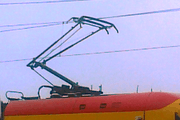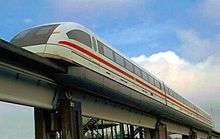Moving load





In structural dynamics this is the load that changes in time the place to which is applied. Examples: vehicles that pass bridges, trains on the track, guideways, etc. In computational models the load is usually applied as:
- a simple massless force,
- an oscillator,
- an inertial force (mass and a massless force).
Numerous historical reviews concerning the moving load problem exist (for example,[1][2]). Several publications deal with similar problems.[3]
The fundamental monograph is devoted to massless loads.[4] Inertial load in numerical models are described in [5] Unexpected property of differential equations that govern the motion of the mass particle travelling on the string, Timoshenko beam, and Mindlin plate is described in.[6] It is the discontinuity of the mass trajectory near the end of the span (well visible in string at the speed v=0.5c). The moving load significantly increases displacements. The critical velocity, at which the growth of displacements is the maximum, must be taken into account in engineering projects. Structures that carry moving loads can have finite dimensions or can be infinite and supported periodically or placed on the elastic foundation.
Let us consider simply supported string of the length l, cross-sectional area A, mass density ρ, tensile force N, subjected to a constant force P moving with constant velocity v. The motion equation of the string under the moving force has a form
Displacements of any point of the simply supported string is given by the sinus series
where
and the natural circular frequency of the string
In the case of inertial moving load the analytical solutions are unknown. The equation of motion is increased by the term related to the inertia of the moving load. A concentrated mass m accompanied by a point force P:

The last term, because of complexity of computations, is often neglected by engineers. The load influence is reduced to the massless load term. Sometimes the oscillator is placed in the contact point. Such approaches are acceptable only in low range of the travelling load velocity. In higher ranges both the amplitude and the frequency of vibrations differ significantly in the case of both types of a load.
The differential equation can be solved in a semi-analytical way only for simple problems. The series determining the solution converges well and 2-3 terms are sufficient in practice. More complex problems can be solved by the finite element method or space-time finite element method.
| massless load | inertial load |
|---|---|
 Vibrations of a string under a moving massless force (v=0.1c); c is the wave speed.  Vibrations of a string under a moving massless force (v=0.5c); c is the wave speed. |
 Vibrations of a string under a moving inertial force (v=0.1c); c is the wave speed.  Vibrations of a string under a moving inertial force (v=0.5c); c is the wave speed. |
The discontinuity of the mass trajectory is also well visible in the Timoshenko beam. High shear stiffness emphasizes the phenomenon.

The Renaudot approach vs. the Yakushev approach
The Renaudot approach
The Yakushev approach
Massless string under moving inertial load
Let us consider a massless string, which is a particular case of moving
inertial load problem. The first solve the problem Smith
.[7]
The analysis will follow the solution of Fryba.[4] Assuming
ρ=0, the equation of motion of a string under a moving mass can
be put into the following form
We impose simply-supported boundary conditions and zero initial conditions. To solve this equation we use the convolution property. We assume dimensionless displacements of the string y and dimensionless time τ :

where wst is the static deflection in the middle of the string. The solution is given by a sum
where α is the dimensionless parameters :
Parameters a, b and c are given below

In the case of α=1 the considered problem has a closed solution
References
- ↑ C.E. Inglis. A mathematical treatise on vibrations in railway bridges. Cambridge University Press, 1934.
- ↑ A. Schallenkamp. Schwingungen von Tragern bei bewegten Lasten. Ingenieur-Archiv, 8, 182-198, 1937.
- ↑ A.V. Pesterev; L.A. Bergman; C.A. Tan; T.C. Tsao; B. Yang (2003). "On asymptotics of the solution of the moving oscillator problem" (PDF). J. Sound and Vibr. 260. pp. 519–536.
- 1 2 L. Fryba (1999). Vibrations of solids and structures under moving loads. Thomas Telford House.
- ↑ C.I. Bajer & B. Dyniewicz (2012). Numerical analysis of vibrations of structures under moving inertial load. Springer.
- ↑ B. Dyniewicz & C.I. Bajer (2009). "Paradox of the particle's trajectory moving on a string". Arch. Appl. Mech. 79 (3). pp. 213–223.
- ↑ C.E. Smith (1964). "Motion of a stretched string carrying a moving mass particle". J. Appl. Mech. 31 (1). pp. 29–37.